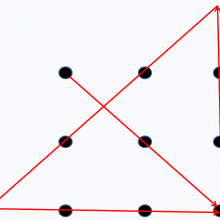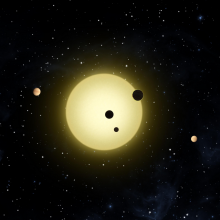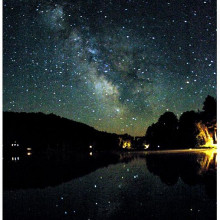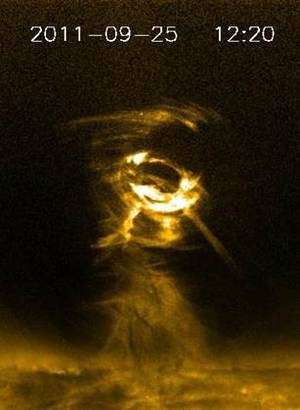A Thinking Cap for Problem Solving
This week, we find out how our brains can be stimulated to think outside the box when solving problems, how ancient raindrops can provide insight into our early atmosphere and how spacecraft could be soon be launched by a pint-sized rocket. Plus, how pesticides are reducing bumblebee populations and tackling antibiotic resistance with chemical compounds...
In this episode

00:17 - Thinking cap makes impossible problem soluble
Thinking cap makes impossible problem soluble
A small dose of electrical current passed across their heads enabled a  group of volunteers to immediately solve a puzzle they had previously found to be impossible.
group of volunteers to immediately solve a puzzle they had previously found to be impossible.
This surprising result is the work of Sydney University's Centre for the Mind scientists Allan Snyder and Richard Chi, who have published their results on the "nine dot problem" as it's known in the journal Neuroscience Letters.
This puzzle, which has thwarted study volunteers for over a century and, under laboratory conditions, is expected to have a solution rate of 0%, involves connecting a pattern of 9 dots - arranged in a 3x3 grid - using four straight lines drawn without lifting the pen from the paper or retracing any lines.
Twenty two volunteers in the Sydney study were initially unable to solve the problem during a 9 minute period. Half of the group then underwent ten minutes of transcranial direct current stimulation, which involved passing a 2 milliamp current across their heads with the positive electrode applied to the right temple and the negative electrode on the left.
Following this treatment, 40% of the subjects then solved the problem. A control group meanwhile, to whom the electrodes were attached but no electrical current applied, were still unable to solve the problem.
According to Snyder and Chi, people find this puzzle so difficult because the dominant left temporal lobe uses prior knowledge of shapes to interpret the pattern of dots as a square with imposed rigid boundaries. And as the solution requires drawing lines outside of this shape, subjects think "inside the box" and don't spot it.
The electrical current, however, boosts activity on the more creative right side of the brain and reduces the activity in the creativity-suppressing left side, freeing the subject from their existing cognitive biases and enabling them to see the solution.
Intriguingly, one subject recruited by the researchers but not included in the analysis did immediately solve the puzzle without the benefit of electrical stimulation. But, on further questioning, he revealed having had a head injury as a child that damaged his left temporal lobe.
This supports their theory, the researchers say, concluding that brain stimulation has the potential to facilitate those tasks that our minds are not well adapted for.

01:14 - A Thinking Cap for Problem Solving
A Thinking Cap for Problem Solving
This week, we find out how our brains can be stimulated to think outside the box when solving problems, how ancient raindrops can provide insight into our early atmosphere and how spacecraft could be soon be launched by a pint-sized rocket. Plus, how pesticides are reducing bumblebee populations and tackling antibiotic resistance with chemical compounds...

05:16 - Life's building blocks found in a ring around the Sun
Life's building blocks found in a ring around the Sun
Complex carbon-based molecules, including many that are important for life on Earth, could have formed in the early solar system. That's according to a paper by Fred Ciesla and Scott Sandford in this week's issue of the journal Science, based on their computational simulations.
The origin of these prebiotic molecules has been a long-standing puzzle. In order for simple stable molecules such as carbon dioxide and methanol to rearrange themselves into more complex configurations, two conditions are thought to be needed.
In order to break the simple configurations apart, ultraviolet light is needed, and in order for the fragments to then be rearranged into different configurations, a heat source is needed. Until recently it was thought that all of the organic material on Earth had originated in situ, helped by lightningstorms in the Earth's early history.
However, recent evidence is that organic molecules are quite widespread in the Universe. They have been found on interplanetary dust grains and in meteorites arriving on Earth; furthermore, their spectral signatures can be seen in many star-forming nebulae far beyond our own solar system. This suggests that they can form in a much more widespread environment than simply the atmospheres ofplanets.
Until now, the early solar system had been ruled out as such an environment. The protoplanetary disk of gas and dust which formed into the planets was so dense that only its innermost parts would have been exposed to the Sun's ultraviolet radiation.
But writing in Science this week, Ciesla & Sandford report on computational simulations of the migration of material within such disks, taking into account effects such as the evolution of the disk and the turbulence within it.
They conclude that there would have been very significant mixing of material as the solar system was forming, and that much of the material would at some point, by random chance, have found itself elevated slightly out of the top or the bottom of the disk. Here, it would have had a clear line-of-sight to the Sun.
Even if this only happened for a thousand years for a typical dust grain, out of a total lifetime of around a million years for the disk, that would have been enough time for substantial chemical changes to occur.
By comparing their simulations with laboratory experiments to determine the amount of ultraviolet irradiation needed to produce chemical changes, Ciesla & Sandford conclude that this would have been ample time to account for all of prebiotic molecules found in the solar system today.
The question remains as to how these molecules went on to form still larger and more complex molecules, such as amino acids and proteins, and how these eventually led to life on Earth, but forming the prebiotic building blocks is an important step along the way.

07:55 - Thinking cap makes impossible problem soluble
Thinking cap makes impossible problem soluble
A small dose of electrical current passed across their heads enabled a  group of volunteers to immediately solve a puzzle they had previously found to be impossible.
group of volunteers to immediately solve a puzzle they had previously found to be impossible.
This surprising result is the work of Sydney University's Centre for the Mind scientists Allan Snyder and Richard Chi, who have published their results on the "nine dot problem" as it's known in the journal Neuroscience Letters.
This puzzle, which has thwarted study volunteers for over a century and, under laboratory conditions, is expected to have a solution rate of 0%, involves connecting a pattern of 9 dots - arranged in a 3x3 grid - using four straight lines drawn without lifting the pen from the paper or retracing any lines.
Twenty two volunteers in the Sydney study were initially unable to solve the problem during a 9 minute period. Half of the group then underwent ten minutes of transcranial direct current stimulation, which involved passing a 2 milliamp current across their heads with the positive electrode applied to the right temple and the negative electrode on the left.
Following this treatment, 40% of the subjects then solved the problem. A control group meanwhile, to whom the electrodes were attached but no electrical current applied, were still unable to solve the problem.
According to Snyder and Chi, people find this puzzle so difficult because the dominant left temporal lobe uses prior knowledge of shapes to interpret the pattern of dots as a square with imposed rigid boundaries. And as the solution requires drawing lines outside of this shape, subjects think "inside the box" and don't spot it.
The electrical current, however, boosts activity on the more creative right side of the brain and reduces the activity in the creativity-suppressing left side, freeing the subject from their existing cognitive biases and enabling them to see the solution.
Intriguingly, one subject recruited by the researchers but not included in the analysis did immediately solve the puzzle without the benefit of electrical stimulation. But, on further questioning, he revealed having had a head injury as a child that damaged his left temporal lobe.
This supports their theory, the researchers say, concluding that brain stimulation has the potential to facilitate those tasks that our minds are not well adapted for.

11:39 - The National Astronomy Meeting 2012
The National Astronomy Meeting 2012
Ben Valsler, The Naked Scientists
Ben - NAM is the annual meeting of the Royal Astronomical Society. Although this year was a little bit special because it was in partnership with the German Astronomical Society, the Astronomische Gesellschaft. It's sponsored by the STFC and also the University of Manchester as this year's event was held in Manchester University. There were nearly 1,000 delegates, hundreds and hundreds of presentations, exciting public events, plenaries, and some fun social events as well.
Chris - Now off course, you make
Naked Astronomy which is our podcast that Dominic also appears on so I presume this is going to turn into an episode of Naked Astronomy. But without giving the game away too much, what were the top stories that you saw this week?
 Ben - Well, the one that seems to have really gathered the most coverage is an image that's been called the "billion stars photograph" even though there are actually far more than a billion stars in it. It's a photograph of the Milky Way put together by people at the University of Edinburgh from images taken by two different infrared telescopes. There's the UK infrared telescope in Hawaii, and Vista which is in Chile. All in all, it comes to 150 gigapixels. If you think that your digital camera might be 10 megapixels, that's 1500 photos tiled next to each other. They worked out that if you were to print it out, it would be about 200 metres wide. So it's a huge image and it's an image of our Milky Way.
Ben - Well, the one that seems to have really gathered the most coverage is an image that's been called the "billion stars photograph" even though there are actually far more than a billion stars in it. It's a photograph of the Milky Way put together by people at the University of Edinburgh from images taken by two different infrared telescopes. There's the UK infrared telescope in Hawaii, and Vista which is in Chile. All in all, it comes to 150 gigapixels. If you think that your digital camera might be 10 megapixels, that's 1500 photos tiled next to each other. They worked out that if you were to print it out, it would be about 200 metres wide. So it's a huge image and it's an image of our Milky Way.
Chris - Nice, but why is it important?
Ben - Well, it's very useful for testing algorithms that are designed for spotting interesting or unusual objects and it's part of something called the Vista Data Flow System. The idea is that we use this to calibrate new telescopes and essentially to archive astronomical data so people can easily use that image to give us an idea of what is actually there at a given time in the Milky Way.
Chris - Meteors?
Ben - It's also been found that Jupiter and the resonant orbits between Jupiter and Haley's Comet are responsible for when we get spectacular meteor showers which are known as meteor outbursts. There was one of these back in 1993, another in 2006, and now, researchers at Armagh Observatory in Northern Ireland think that this is because of the gravitational impact of Jupiter which slightly restricts the orbit so that you get a bunching up of the stuff that falls out of Haley's Comet. When we then go through that bit of the tail in Earth's orbit, we get this spectacular meteor shower.
Chris - But we've got to live another - I don't know- 70 years, 60 years to see it, haven't we now?
Ben - Well, the next one is going to be in 2070, yes, but they do argue that there's still an awful lot of good science that we can do between now and then.
Chris - Terrific! And finish this up by telling us about the dark energy material they presented.
Ben - Well this is based on the Sloan Digital Sky Survey 3 (SDSS-3) and using a survey called BOSS - that's Baryon Oscillation Spectroscopic Survey. What they've done is looked at over 250,000 galaxies and essentially done a statistical analysis where you can see how they clump together, and the clumping together can give you some idea of the waves that formed in the very, very early universe before atoms even condensed out of the incredibly hot plasma.
These waves got "fixed" in place so if we look at these waves at different times, we can look at the expansion of the universe by looking at the size of those wavelengths. Researchers working on BOSS have worked out that dark energy, this incredible force that is driving the expansion of the universe to get faster and faster, seems to have taken over somewhere between 5.5 and 6.5 billion years ago. Before that, the dominant force in the universe was gravity holding everything together and after that, it's been dark energy that's been causing the universe to expand. That won a Nobel Prize when it was first discovered. So now, working out what it is that's doing it is a big question in astronomy.

16:02 - Ancient Raindrops provide Insight into our Early Atmosphere
Ancient Raindrops provide Insight into our Early Atmosphere
Roger Buick, University of Washington
Chris - What was the atmosphere like on the Earth nearly 3 billion years ago? Well that's a pretty tough question to answer, but incredibly, some fossilised raindrops or rather, the patterns that they left behind when they fell 2.7 billion years ago have enabled scientists to reconstruct some aspects of what the air that rain fell through would've been like. And with us to explain how, from the University of Washington in Seattle is Roger Buick who's one of the authors on the study. Hello, Roger.
Roger - Good day!
Chris - So what are you actually trying to understand about the early atmosphere?
Roger - What we really want to know is why the Earth wasn't an ice ball 3 billion years ago. The Sun was only 80% as bright then as it is now and if the atmosphere was the same as it is now on the Earth, the planet should've been completely frozen over.
Chris - Yet we've got geological evidence of their having been running water and quite a balmy climate.
 Roger - There's abundant geological evidence for liquid water - oceans, rivers, lakes, and now rain as well. Either we had to have a much denser atmosphere, or else we had to have a whole lot more greenhouse gases in the atmosphere to keep us warm. And there's been a debate going on for 20 odd years as to what sort of atmospheric warming mechanism was active on the early Earth.
Roger - There's abundant geological evidence for liquid water - oceans, rivers, lakes, and now rain as well. Either we had to have a much denser atmosphere, or else we had to have a whole lot more greenhouse gases in the atmosphere to keep us warm. And there's been a debate going on for 20 odd years as to what sort of atmospheric warming mechanism was active on the early Earth.
Chris - And obviously, without the capacity to go back 3 billion years or so and take a snapshot of that atmosphere, we're forced to rely on indirect measures which I guess is what you've done in this paper in Nature this week. You've used an indirect measure to work out what the atmosphere must have characteristically been like.
Roger - Yeah, well until Torricelli invented the barometer, we've really got no real readings of what atmospheric pressure was like early in Earth history. The atmosphere has a very, very indirect and faint impact on rocks that can get preserved from early in Earth history. So, to be able to register anything about the atmosphere from early in Earth's times is really quite remarkable.
Chris - So how did you actually do this?
Roger - Well, we found some literature records of raindrop imprints in rocks, almost 3 billion years old. There's a number of places in the world where there are these ancient raindrop craters and the best ones that we were able to come across were in South Africa, out in the Karu-velt of South Africa. And so, we went there and took samples of them and made latex peels off them and measured them. Now there's a relationship between the size of raindrop imprints and the speed at which the rain fell, and the speed at which the rain fell is influenced by the atmospheric density. The denser the atmosphere, the slower the raindrops fall, so the smaller the little craters that they form.
Chris - So how do you work out based on the rock samples that you've got from 3 billion years ago, how big the crater should be in proportion to the speed of the raindrops? How did you close that gap in our knowledge?
Roger - Well, the big variable is the nature of the material being impacted. The South African raindrop imprints were in volcanic ash, so what we did was get some equivalent modern volcanic ash from the Icelandic eruption a couple of years ago and did experiments by dropping artificial raindrops down a 7-floor stairwell onto a pie plate full of this volcanic ash...
Chris - It's high tech stuff, this! And so, that was your sort of proxy measure. You could see based on how fast or therefore how much energy, how much momentum, the raindrops had and based on how big a splatter imprint they make you can extrapolate from the latex peels from the South African rocks, how fast the raindrops must've been going 2.7 billion years ago.
Roger - Exactly. The other variable of course is the size of the raindrop. As anybody British will know, raindrops vary greatly in size depending on the intensity of the rainfall.
Chris - Well at the moment, we're in drought in the southeast, so we don't have any rain at all. Zero is the size! So what did you do to constrain that?
Roger - We do know that there is an absolute maximum size to which raindrops can get. It's a proportion of the interplay between the surface tension of the water and the force of gravity trying to pull it to bits. And so, the largest that's ever been recorded on the Earth and the theoretical maximum size from physics is 6.8 mm. So, that sets a maximum bound on what the atmospheric pressure could've been, but it's unlikely that the absolute maximum raindrop size was achieved. Probably more like 5 mm was the realistic maximum raindrop size.
Chris - So putting all that together, what does this tell us about the atmosphere 2.7 billion years ago when these - what are now rocks - were just volcanic ash and this moderate shower was falling on them?
Roger - Well, it us tells that the maximum possible atmospheric pressure was about 1.6 bars, so 1.5 times what it is now, but more likely, it was 1.1 bar, 1.1 atmospheres, well maybe even as low as 0.6 of a bar, so only 6 tenths of our current atmospheric pressure.
Chris - So very, very similar to what we have today which argues that we couldn't have had just this blanketing smog of CO2, giving us an artificial greenhouse effect to keep the Earth warm then.
Roger - That's right. Most likely, we had to have some other sort of greenhouse gas other than just carbon dioxide in the atmosphere to warm the Earth. Maybe something like methane, though that's problematic; if you have high levels of methane in the atmosphere, you produce a haze of organic particles formed by ultraviolet light and that reflects sunlight and has an anti-greenhouse effect. Other possible greenhouse gases would be, my favourite is laughing gas - nitrous oxide. There is some evidence that there was a biological nitrogen cycle producing laughing gas, back as far as about 2.7 billion years ago. So, laughing gas is something like 100 times more effective as a greenhouse gas than carbon dioxide. So we might have had some methane and some laughing gas in the atmosphere as well.

22:49 - Resuscitating Antibiotics and Bumblebees on the Decline
Resuscitating Antibiotics and Bumblebees on the Decline
Dave Goulson, University of Sterling; Marta Martins, University College Dublin; Huw Morgan, University of Aberystwyth; Daniel Frankel, University of Newcastle
Bumblebee numbers reduced by pesticide use
Direct evidence that pesticides are poisoning bumblebees has been revealed ![The buff-tailed bumblebee (Bombus terrestris) visiting Echinops (Globe thistle). Queens and males of this species can be distinguished from the white-tailed bumblebee (Bombus lucorum) by the buff colour of their tail. Workers are more problematic, as the tail is mainly white. However, a fine margin of buff hairs between the white and black bands is usually diagnostic. (c) Penny Frith [PLACEHOLDER, WS#-1]](/sites/default/files/media/Bonbus_Terrestris_05.jpg) this week in the journal
this week in the journal
Science.
By exposing colonies of bumblebees to the commonly used pesticide imidocloprid, Dave Goulson from the University of Stirling found that the bee colonies grew more slowly and there was an 85% reduction in the production of new queens who are crucial for producing future bee generations.
The consequences could be significant for both the environment and the economy...
Dave - If we're accidentally poisoning our bumblebees and driving down their populations, there'll be less pollination for wild flowers and therefore, all the things that those plants support, all the butterflies and birds, and everything else. But there's also a really direct economic importance of bees. Bumblebees are the main pollinators of some of the very nice things that we like to eat - so blueberries, raspberries, strawberries, lots of garden vegetables like beans and tomatoes. So, if we lose our bumblebees, then our diets are going to be much be poorer for it.
---
Resuscitating Antibiotics
Bacteria that have become resistant to antibiotics could be made susceptible to the drugs by the addition of certain chemical compounds.
Presenting at the
Society for General Microbiology annual meeting in Dublin this week, Marta Martins from University College Dublin, combined one of five known pharmaceutical compounds, including phenothiazines used to treat schizophrenia, with the widely prescribed antibiotic ciprofloxacin.
When used on samples of bacteria showing resistance, the combined treatment was six times more effective at killing bacteria than samples lacking these added compounds, giving a new lease of life to the drugs...
Marta - We think this is a better solution instead of developing new antibiotics. With these compounds that are known antibiotics, they are synthetic compounds and we could avoid that problem of the bug adapting to that. It will not just help to treat these multidrug resistant infections but also to decrease the numbers that we will see in the hospital and subsequentially in the community.
---
Solar tornado
 Scientists have spotted a tornado on the Sun, large enough to accommodate several hundred Earth-sized planets.
Scientists have spotted a tornado on the Sun, large enough to accommodate several hundred Earth-sized planets.
Using the orbiting Solar Dynamic Observatory, University of Wales, Aberystwyth physicist Huw Morgan and his colleagues spotted the 120,000km high plasma tornado travelling across the Sun's surface at speeds of 300,000 km per hour, driven by the solar magnetic field.
The discovery was announced this week at the
National Astronomy Meeting in Manchester.
Huw - It's a huge structure and it lasts for 4 or 5 hours, and it's very exciting because it's a test bed for various theories on solar magnetic field and plasma movements in that field.
---
Robots mimicking Living Organisms
And finally, a robot less than 1cm in size with the ability to respond and move like a living organism is being developed by scientists at the University of Newcastle.
Modelled on an ancient fish, the robot named '
cyberplasm' will combine cells engineered to sense light and chemical cues that feed into a central processor that controls a series of artificial muscles resulting in movement.
Daniel Frankel from the University of Newcastle is leading the project.
Daniel - The idea is really to harness the power and control of the biological system. For example, muscle contraction and sensitivity of cells and interface them and incorporate them into a machine. The ideal uses would be swimming into waters which may be polluted or having toxins and detecting toxins, and then in addition, medical applications. For example, reconnaissance in the body so to speak, swimming through the arteries and veins, and trying to detect and maybe even treat various diseases.









Comments
Add a comment